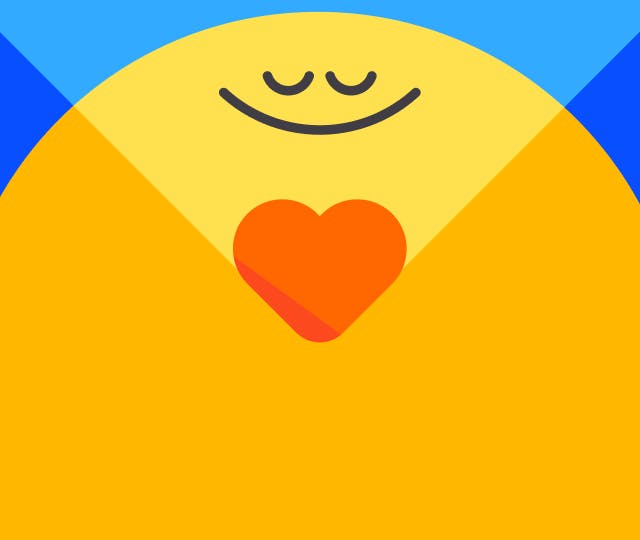The benefits of daily meditation
By Your Headspace Mindfulness & Meditation Experts
Feb 12, 2024
Daily meditation — the practice of staying present and mindful for a limited period of time — can have numerous benefits for our mental and physical health. Yet, many of us don’t meditate every day because we’re too busy or we simply don’t feel like it. Sound familiar?
The thing about meditation though is that we experience even greater benefits when we repeat the practice frequently and consistently. Finding some time each day to meditate — even a short daily meditation — is better than no meditation at all. Here’s information and actionable tips to help you make meditation a part of your regular routine.
What are the positive effects seen with daily meditation?
Science has proven that the benefits of meditation are too good to ignore. And while we don’t need to meditate daily to experience its positive effect on your health and happiness, studies have shown that we can unlock even more benefits when we meditate for consecutive days. In fact, completing just one 15-minute session of meditation using the Headspace app resulted in 22% reduction in mind wandering. And four weeks of using Headspace daily resulted in 14% increase in focus.
When we meditate, we can enhance our focus and decision-making and lessen our feelings of fear and stress. The result: by fundamentally shifting the way we relate to our thoughts and feelings, we can dial down the intensity of emotions that tend to take hold of us, and ultimately experience a greater sense of calm, clarity, and focus in our lives.
The particular benefits of daily generalized meditation are well-documented and widespread, ranging from reduction in anxiousness and lower blood pressure to increased immunity and better sleep. In a study that did not use the Headspace app, researchers from John Hopkins University found general mindfulness meditation programs helped ease psychological symptoms of depression, anxiety, and pain related to stress. According to another study using a generalized form of meditation, people who meditate have lower levels of cortisol, a hormone associated with physical and emotional stress. Generalized meditation has also been shown to improve sleep quality and, for those with chronic pain, increase pain tolerance.
What’s more, people who meditate have also reported improvements in their relationships, likely because meditation stimulates the part of the brain associated with empathy. Three weeks of using the Headspace app was found to increase compassion in study participants by 23%.
In short, there are so many scientifically-backed ways meditation can help your mind and body.
Try this short daily meditation from Headspace
Mini-Meditation: Unwind
1 min
How to establish a daily meditation routine
There’s no way around it: creating a regular habit can help unlock even more benefits of meditation. In fact, research shows that frequency is even more important than duration — meaning, that meditating for 10 minutes a day, seven days a week is more beneficial than 70 minutes one day a week.
Many people who are new to meditation — and even many who’ve been doing it for a while for that matter — find it challenging to maintain a daily practice. That’s why the “little and often” approach to meditation is so effective compared to isolated practices we do once in a while and then leave behind. Committing to a short daily meditation allows your brain to learn at its own pace how to be present in the here and now and how to extend that awareness to everyday activities.
As with any habit, daily meditation becomes easier when it’s part of your routine. Once it becomes a habit, we stop making excuses — we’re too busy, we don’t get anything out of it — and instead, we simply meditate. So how does daily meditation become a habit that sticks?
Here's how to get started
Here’s how to get started:
1. Decide on a time and place that works for you. One of the most effective ways to turn your meditation practice into a habit is by aiming to do it in the “same time, same place” every day. Many people prefer meditating first thing in the morning — before the day gets too busy — because it sets them up for a mindful day. But the best time to meditate is really whenever you can best prioritize it. As for the ideal place? There isn’t any. Simply, choose a quiet place to meditate where you feel warm and relaxed and distractions are minimal.
2. Decide on an amount of time to meditate. Particularly for beginners, starting with small, manageable chunks of time — for example, 3, 5, or 10 minutes — is key so you can build up your practice and find your sweet spot (which varies for everyone). The most important thing is to find an amount of time that is effective, yet also feels achievable and keeps you motivated. That’s the only way you’ll keep showing up day after day.
Research shows that combining a 30-second action with a “habit anchor” can make new routines more likely to stick. The 30-second action can be anything that might prompt you to start your new daily meditation routine (For example: “I will count 15 inhales and exhale breath cycles for 30 seconds before I start meditating”). And the habit anchor is something you already do as part of an existing daily routine that you can attach that new 30-second action to (such as “I will begin counting my breaths as soon as I finish brushing my teeth”).
3. Make yourself comfortable. Choose a meditation posture that feels good for your body. This could be sitting in a chair or on a couch with feet flat on the floor, kneeling, legs crossed on a firm cushion or yoga mat, lying down on your back, or even standing or walking. If you’re sitting, try to keep your back straight, your hands resting on your lap or knees, your eyes gazing softly into the middle distance or at a spot on the floor in front of you. Posture can be important for focus, however, feeling comfortable is more important. So, feel free to choose whatever position feels best for you (and, know that this position could change depending on the day). Comfortable clothes are ideal, and you can even drape a blanket over yourself if you tend to feel cold while sitting still if that feels more pleasant.
4. Use a guide, such as an app. A guide or a guided meditation app — like the Headspace app — can be a useful, accessible tool for building a daily meditation practice. Most meditation apps are designed for both beginner and seasoned meditators and offer valuable instruction, insights, and support on a variety of topics.
Find a meditation for today
Headspace has several features that can help you create a daily meditation practice and set you on the path for a happier, healthier life. The run streak feature records the number of days you have meditated in a row. Seeing how consistently you’ve been working toward your goal can help keep you on track with meditating — helping you follow through on your intention and commitment to a daily meditation practice. Everyday Headspace is another effective feature, particularly for those who like variety in their practice. Delivered to your phone and found on the Headspace app home screen, it’s a daily meditation on a different topic each day.
There are also super-short meditations you can do on those days when you can only squeeze in a minute or two. And of course, Headspace offers hundreds of themed meditations with adjustable durations on everything from sleep and anxiety to mindful eating and self-esteem. When you’re ready, press play on Headspace’s 10-day beginner’s course on mindfulness basics — available with your membership or free trial. Jump into your new practice with the essentials.
Be kind to your mind. Start with a free trial of Headspace.


Be kind to your mind
- Access the full library of 500+ meditations on everything from stress, to resilience, to compassion
- Put your mind to bed with sleep sounds, music, and wind-down exercises
- Make mindfulness a part of your daily routine with tension-releasing workouts, relaxing yoga, Focus music playlists, and more

Learn more about meditation

Stay in the loop
Be the first to get updates on our latest content, special offers, and new features.
By signing up, you’re agreeing to receive marketing emails from Headspace. You can unsubscribe at any time. For more details, check out our Privacy Policy.
- © 2026 Headspace Inc.
- Terms & conditions
- Privacy policy
- Consumer Health Data
- Your privacy choices
- CA Privacy Notice







